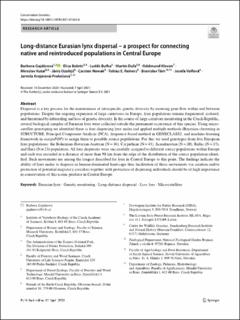Long-distance Eurasian lynx dispersal – a prospect for connecting native and reintroduced populations in Central Europe
Gajdárová, Barbora; Belotti, Elisa; Bufka, Luděk; Duľa, Martin; Kleven, Oddmund; Kutal, Miroslav; Ozoliņš, Jānis; Nowak, Carsten; Reiners, Tobias E.; Tám, Branislav; Volfová, Josefa; Krojerová-Prokešová, Jarmila
Peer reviewed, Journal article

Åpne
Permanent lenke
https://hdl.handle.net/11250/2755741Utgivelsesdato
2021Metadata
Vis full innførselSamlinger
- Scientific publications [1392]
Originalversjon
10.1007/s10592-021-01363-0Sammendrag
Dispersal is a key process for the maintenance of intraspecifc genetic diversity by ensuring gene fow within and between populations. Despite the ongoing expansion of large carnivores in Europe, lynx populations remain fragmented, isolated, and threatened by inbreeding and loss of genetic diversity. In the course of large carnivore monitoring in the Czech Republic, several biological samples of Eurasian lynx were collected outside the permanent occurrence of this species. Using micro-satellite genotyping we identifed these as four dispersing lynx males and applied multiple methods (Bayesian clustering in
STRUCTURE, Principal Component Analysis (PCA), frequency-based method in GENECLASS2, and machine-learning framework in assignPOP) to assign them to possible source populations. For this we used genotypes from five European lynx populations: the Bohemian-Bavarian-Austrian (N=36), Carpathian (N=43), Scandinavian (N=20), Baltic (N=15), and Harz (N=23) population. All four dispersers were successfully assigned to diferent source populations within Europe and each was recorded at a distance of more than 98 km from the edge of the distribution of the source population identifed. Such movements are among the longest described for lynx in Central Europe to this point. The fndings indicate the ability of lynx males to disperse in human-dominated landscape thus facilitation of these movements via creation and/or protection of potential migratory corridors together with protection of dispersing individuals should be of high importance in conservation of this iconic predator in Central Europe.
